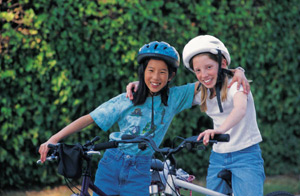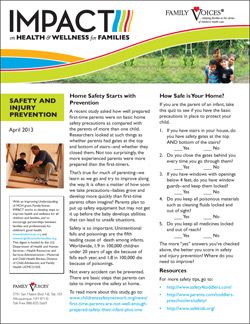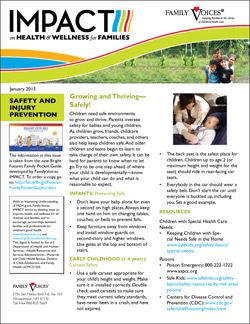
SAFETY and INJURY PREVENTION
SECTIONS: Background ~ Child and Family ~ Ages and Stages ~ What You Can Do

Children need a safe environment to grow and thrive. At first, parents are in charge of safety for babies and young children. As children grow, friends, neighbors, childcare providers, teachers, coaches, and others also help keep children safe. Older children and teens learn to take charge of their own safety. It can be hard for parents to know when to let go. It helps to know:
Safety and injury prevention are part of child development. Knowing what your child can and cannot do will help you set limits on your child's activities and the places you go. As your child's world expands beyond the home and any childcare settings, other members of your community work to make sure all children are safe near your home, at school, on the playground, and in other places in your community.Primary care providers, emergency responders, hospital workers, and others are there to help if an injury or accident does occur.
Child and Family
Maintaining a safe environment requires a constant watchful eye. Children grow and learn new skills daily. Their idea of what they can do does not always match what they can safely do! This is especially true for babies who have just learned to walk. This also applies to teens that have just learned to drive. Parents of children with special health needs will have to balance their children's skills and safety issues so their children can be as independent as possible.
Talking about safety and injury prevention can be scary. There are lots of dos and don'ts. There are many horror stories about injuries that can make even the calmest parent worry! Try to find a balance between safety rules and helping your child understand what can happen if he or she breaks the rule. Your health care provider is an important resource and can work with you to create a safe environment for your child.
The two broad categories of injuries for infants, children, teens, and young adults:
- Unintentional injury: These include accidents - car accidents, falls, burns, sports injuries, etc. Following safety rules can help prevent these types of injuries. For example, teach your child to always wear a seatbelt in the car, a bike helmet when riding, to look both ways before crossing the street, not to touch a hot stove, or turn on the hot water alone.
- Intentional injury: Examples include when someone tries to inflict self-harm, or bully or abuse others. Sadly, homicide and suicide rates go up as children get older. These kinds of injuries have a mental health component that can be key to prevention and treatment.
Ages and Stages
- Pregnancy: Babies live in a protected environment for 9 months before birth. Even so, falls, alcohol use, smoking, and some medications can hurt your baby before she is born. Mothers need to take care of themselves!
- Infancy: It is a 24/7 job to make keep your baby safe. Always put your baby in an infant car seat when riding in the car. Provide a safe place for your baby to sleep and put your baby to sleep on his back. Get down on your hands and knees and crawl through your home to see what your baby will see and remove dangerous small objects and pad hard surfaces.
- Early Childhood: One to four year olds learn new skills by the hour. They think they can do more than they really can. Try to set limits without a constant stream of "No! No! No!" By creating safe play space, you won't have to say no all the time. If someone else is helping to care for your child in your home, explain the safety rules. If your child is being cared out of your home, visit the setting. Ask about safety rules, and share your own.
- Middle Childhood: Teachers and others help keep school-aged children safe. Parents should teach their children to be safe when visiting with friends. Teach your child about unsafe situations outside of your home. This might include a home with guns. Bullies can be a serious problem for 5 – 10 year olds. Teach children tips for dealing with bullies.
- Adolescence: Teens are developing more relationships outside their families. They are influenced by friends, the media, and the Internet. They do not always make good decisions about being safe and avoiding injury. Talk to your teen about sports, driving, sex, smoking, drinking, and gang activity. Work with your community to make it safe for all children.
What Can Families Do to Promote Safety & Injury Prevention?
Families can play a major role in keeping children and teens safe:
- Try to be one step ahead of where your child is developmentally. Know what your child can do and what is reasonable to expect.
- Keep the lines of communication open. Explain safety rules and guidelines in ways that your child can understand. Take time to listen to your child's point of view and any fears.
- Be aware of potential dangers in your home and community. Alert other caregivers.
- Seek help when you need it. Your health care provider can be the best resource for help.
Look for ways to prevent injuries from happening:
- Make sure your safety equipment is working. For example, make sure your car seat is securely and correctly installed in your car. Make sure older children have good quality helmets that fit well for bicycling and other sports.
- Keep guns locked away.
- Take an active role in your community to make sure schools, parks, and playgrounds are safe places to play.
Be prepared in the case of injury:
- Take a First Aid and CPR (Cardio Pulmonary Resuscitation) class at your local hospital, Red Cross, American Heart Association, or other community organization.
- Have a first aid kit and post a list of emergency telephone numbers, including the National Poison Control Center (800-222-1222) near the phones. Enter emergency numbers into cell phones.
- Know when to call a health care provider. If you aren't sure, it is best to go ahead and call. Discuss when to go to the emergency room and when to call 911.
- If your child has special health care needs, alert local emergency responders so they'll be prepared in the event of an emergency.
ADDITIONAL RESOURCES:
Download Project IMPACT
1-page updates:
2 updates found



